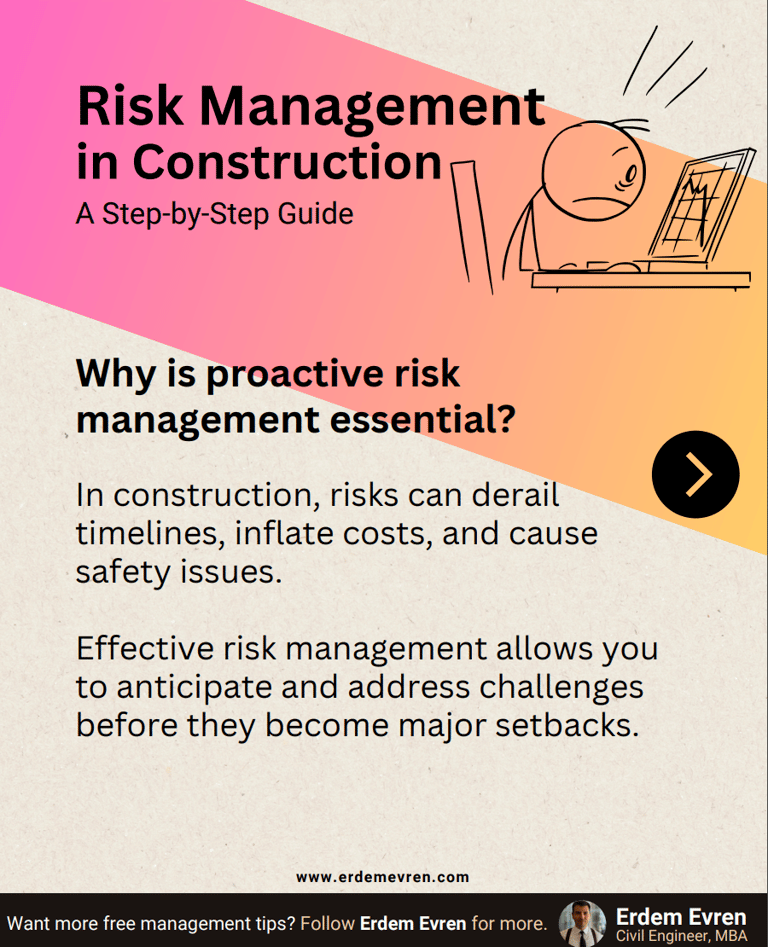Effective Risk Management Strategies – Minimize Business Risks
Concise yet insightful!


𝗛𝗼𝘄 𝘁𝗼 𝗔𝗰𝗵𝗶𝗲𝘃𝗲 𝗘𝗳𝗳𝗲𝗰𝘁𝗶𝘃𝗲 𝗥𝗶𝘀𝗸 𝗠𝗮𝗻𝗮𝗴𝗲𝗺𝗲𝗻𝘁 𝗶𝗻 𝗖𝗼𝗻𝘀𝘁𝗿𝘂𝗰𝘁𝗶𝗼𝗻? In the fast-paced world of construction, risk is everywhere. But effective risk management can be your secret weapon to ensuring project success. Whether it’s staying on budget, keeping timelines in check, or preventing safety hazards, the key is being proactive and prepared. 💼
In my latest carousel, I break down 5 essential tips for achieving effective risk management:
🟦 𝗜𝗱𝗲𝗻𝘁𝗶𝗳𝘆 𝗥𝗶𝘀𝗸𝘀 𝗘𝗮𝗿𝗹𝘆 𝗶𝗻 𝘁𝗵𝗲 𝗣𝗹𝗮𝗻𝗻𝗶𝗻𝗴 𝗣𝗵𝗮𝘀𝗲
When you catch potential risks early, you can deal with them before they grow into larger issues. This step includes using tools like risk assessments and team brainstorming to uncover potential budget overruns, resource shortages, and delays.
🟥 𝗣𝗿𝗶𝗼𝗿𝗶𝘁𝗶𝘇𝗲 𝗥𝗶𝘀𝗸𝘀 𝗕𝗮𝘀𝗲𝗱 𝗼𝗻 𝗜𝗺𝗽𝗮𝗰𝘁
Not every risk needs equal attention. By using a risk matrix, you can categorize risks based on their potential impact and likelihood of occurring. This helps you focus on addressing the most critical risks first.
🟧 𝗗𝗲𝘃𝗲𝗹𝗼𝗽 𝗠𝗶𝘁𝗶𝗴𝗮𝘁𝗶𝗼𝗻 𝗣𝗹𝗮𝗻𝘀 𝗳𝗼𝗿 𝗛𝗶𝗴𝗵-𝗥𝗶𝘀𝗸 𝗔𝗿𝗲𝗮𝘀
Once you’ve identified your high-priority risks, develop a comprehensive strategy to mitigate them. Contingency plans, resource allocation, and scenario planning will help you tackle these risks effectively.
🟩 𝗖𝗼𝗻𝘁𝗶𝗻𝘂𝗼𝘂𝘀𝗹𝘆 𝗠𝗼𝗻𝗶𝘁𝗼𝗿 𝗮𝗻𝗱 𝗔𝗱𝗷𝘂𝘀𝘁 𝗥𝗶𝘀𝗸 𝗦𝘁𝗿𝗮𝘁𝗲𝗴𝗶𝗲𝘀
Risks evolve as your project progresses. That’s why it’s critical to continuously monitor for new risks and adjust your risk management strategies to stay ahead. Holding regular team check-ins and using key performance indicators (KPIs) can keep you informed and prepared.
🟨 𝗟𝗲𝘃𝗲𝗿𝗮𝗴𝗲 𝗧𝗲𝗰𝗵𝗻𝗼𝗹𝗼𝗴𝘆 𝗳𝗼𝗿 𝗣𝗿𝗲𝗱𝗶𝗰𝘁𝗶𝘃𝗲 𝗥𝗶𝘀𝗸 𝗔𝗻𝗮𝗹𝘆𝘁𝗶𝗰𝘀
Using tools like Excel VBA and Building Information Modeling (BIM), you can predict potential risks before they happen. In the carousel, I provide practical examples of how to use Excel VBA to automate risk dashboards, simulate risk scenarios with Monte Carlo simulations, and set up automated alerts for critical indicators.
𝗛𝗼𝘄 𝗱𝗼𝗲𝘀 𝘁𝗵𝗶𝘀 𝘄𝗼𝗿𝗸?
𝗘𝘅𝗰𝗲𝗹 𝗩𝗕𝗔 𝗳𝗼𝗿 𝗥𝗶𝘀𝗸 𝗠𝗮𝗻𝗮𝗴𝗲𝗺𝗲𝗻𝘁:
-Automate your risk tracking and alerts, and simulate potential risk scenarios using historical project data.
𝗣𝗿𝗶𝗺𝗮𝘃𝗲𝗿𝗮 𝗣𝟲:
- Utilize the built-in risk analysis features in Primavera P6 to predict delays, cost overruns, and other project risks.
- Integrate your risk data with project schedules to get real-time insights and forecasts for better planning.
